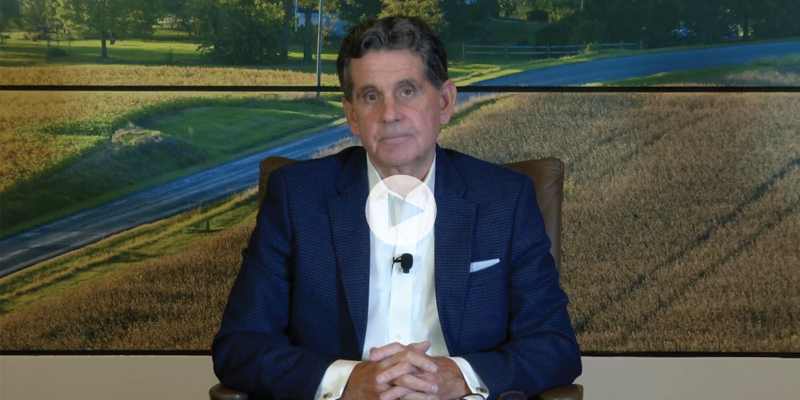Petersen: Co-ops’ Strengths Offer Benefit in COVID Response

The pandemic is testing companies’ ability to respond to and manage risk, care for communities, and strategically position themselves for the future, but electric cooperatives have several key strengths that give them an advantage in responding, CFC CEO Sheldon Petersen said in remarks during NRECA’s Online Regional Week on October 14, 2020.
“While the transition to a post-COVID world will clearly vary by business and industry, I believe electric cooperatives are in an enviable position right now,” Petersen said.
Petersen pointed to three key strengths that are especially relevant: the strength of electric cooperative financials, the strength of the electric cooperative network and the strength of electric cooperative culture. These strengths, he said, will help electric cooperatives adapt to a business environment that is being reshaped by the shift to digital technologies, remote work, an increasing focus on resilience and rising expectations for companies to live their values.
In discussing the strength of electric cooperative financials, Petersen highlighted two ratios from CFC’s Key Ratio Trends Analysis data that demonstrate resilience: equity as a percent of assets and the times interest earned ratio, or TIER. Over the last 45 years, equity as a percent of assets increased from 31 percent to 46 percent, while TIER increased from 2.56 to 2.64, despite many ups and downs in kWh sales.
“Your ability to manage cost and revenue in challenging times has been repeatedly recognized by the credit rating agencies,” Petersen said. To reinforce this point, he cited a comment from Fitch’s October credit profile: “CFC’s borrowers operate in a defensive industry that has historically been resilient to economic downturns.”
Electric Cooperatives Are Strongest When Working Together
In highlighting the strength of the electric cooperative network, Petersen noted that the network can help electric cooperatives do things that would otherwise be challenging to accomplish alone. “When we think about how electric co-ops will navigate not just the current crisis, but ‘the next normal,’ it’s important to consider what our network brings to the table: economies of scale, innovation, collaboration, a diversity of resources, credibility and influence,” Petersen said.
The reason why the network is possible, Petersen said, has to do with the strength of the electric cooperative culture. “It would be hard to overstate just how important—or how powerful—our electric cooperative culture is,” he stated. “It’s a culture based around our shared mission of service. In fact, if I had to sum up our culture in one phrase, I would point to the seventh cooperative principle: Concern for Community.”
While many companies are going out of their way to tout their values and concern for community, electric cooperatives are “the real deal,” Petersen said. “When we talk about our shared mission of service, it’s not a PR gimmick. It’s the core of who we are and why we do what we do!”
In looking to the future, Petersen said, electric cooperatives will be able to leverage these strengths to help them not only adapt and thrive operationally, but also create more sustainable, more livable and more connected rural communities.
CFC’s Sustainability Bond to Fund Rural Broadband, Renewable Energy Projects
To underscore this point, Petersen highlighted CFC’s first-ever Sustainability Bond, which was issued on September 29 to help finance rural broadband and renewable energy projects. “Considering the growing popularity of ESG investments, we expected the issuance to do well,” Petersen explained. “But even with high expectations going in, we were amazed at the result.”
The transaction was launched at $350 million and received $1.4 billion in orders. This allowed CFC to upsize the transaction to $400 million and issue a 10-year bond at an all-in rate of 1.35 percent, the lowest all-in coupon ever for a 10-year taxable bond in the electric utility space.
Making history with the deal was exciting, Petersen said, but the real satisfaction is how it supports rural communities, and also recognizes and highlights the good works of electric cooperatives. “This new bond demonstrates CFC’s and our member cooperatives’ commitment to the communities we serve—it’s Concern for Community in action,” he said. “It also underscores investors’ confidence in CFC and in you.”
Petersen added, “And that is the most impressive thing about this bond issuance: CFC could only do this because of what you do. You’re at the forefront of doing the great deeds the bond finances: renewables and broadband ... We’re financing the projects you’re doing.”
Network Is Well Positioned for Current Challenges
Petersen concluded by stating he isn’t surprised that the electric cooperative network has done a tremendous job in navigating the current challenges and uncertainties facing the country. “We have an adaptable, flexible culture. We are building more resilience together and empowering rural communities. We also have the trust of our members and communities. When it comes to ‘concern for community,’ our cooperative program is the gold standard.”
He concluded: “As we look ahead to the future, I believe we will continue to be adaptive and identify even more opportunities. I believe co-ops will ultimately emerge from the pandemic even stronger than we were heading into it. I would argue that electric cooperatives—and CFC—are in an enviable position.”
Published Oct. 27, 2020, in CFC Solutions News Bulletin.